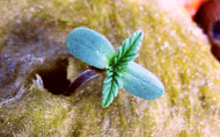You are hereTop-Fed DWC Cannabis Setup Guide - Bubbleponics
Top-Fed DWC Cannabis Setup Guide - Bubbleponics
by Sirius Fourside
Table of Contents
Pros & Cons of Bubbleponics Method
Overview of Growing Cannabis With Bubbleponics
How To Make Your Bubbleponics System
Introduction
Welcome, cannabis growers!
This is our cannabis bubbleponics grow guide to get you started growing marijuana with any 'Top Fed Deep Water Culture' hydroponic grow systems (aka 'Bubblers').
Somewhere out in the internet, a gracious fellow named Roseman made growing cannabis in water seem accessible to a lot of people. Now there are dozens of "bubbleheads" who grow marijuana using bubbleponics. Hopefully this step-by-step walkthrough will make growing weed with bubbleponics even easier for you and others to get started!
As time goes on, we'll make sure to update this with any new practical info we get our hands on! If you have any suggestions or feedback, we'd love to hear from you! Keeping this short and sweet is key to getting you going quicker, so without further ado...
This step-by-step grow guide will teach you how easy it is to grow your own cannabis using bubbleponics. Growing cannabis with bubbleponics was originally pioneered by a grower by the name of Roseman.
Growing your marijuana buds using bubbleponics is one of the best techniques to get consistent huge yields and allows for quicker harvest than almost any other grow method.
When we were first learning about how to grow cannabis with bubbleponics, we had to read through hundred of forum posts by Roseman to get started. However, after reading all of Roseman's information, and after going through a few cannabis grows using bubbleponics, we believe we have discovered the easiest and best techniques to ensure a successful cannabis grow with great yields.
We hope that we can use our research and experience to provide you with a simple, easy-to-follow cannabis grow tutorial that will help you succeed with getting great yields through bubbleponics on your very first attempt!
Pros of Growing Cannabis with Bubbleponics:
-
Very high yields compared to the amount of light/nutrients/time that goes into each plant
-
Quick growth (I've personally seen marijuana plants grow 2-3 inches a day using this system)
-
Not hard to maintain once it's set up
-
Doesn't need much room (can fit in your closet)
Cons of Growing Cannabis with Bubbleponics:
-
A full bubbleponic setup can be a bit of work to get set up
-
Because your cannabis roots are growing directly in water, you are more likely to experience problems with root rot and other types of root problems. However, these problems are easy to prevent with a little foresight.
-
Because it's crucial to maintain proper temperatures when growing cannabis with hydroponics, you will probably want to avoid trying this system with an HID light unless you have a proper venting/exhaust system. Bubbleponics works astonishingly well with HPS and MH lights if temps are kept under control. This system also works great with CFLs or LEDs since they don't produce much heat.
"Bubbleponics" is just a fancy word to describe a top-fed Deep Water Culture (DWC) hydroponic system.
The basic idea behind bubbleponics is you feed the cannabis with flowing, nutrient filled water that flows over their roots into a reservoir of water below.
The roots are allowed to hang without a medium in order to get the best access to water, oxygen, and nutrients.
You may not know, but while cannabis leaves need CO2, the cannabis roots actually need oxygen. Cannabis roots normally get the oxygen they need in the water, which is why all the water in a bubbleponics system is constantly moving to dissolve as much oxygen in the water as possible. The roots hang in net pots and then eventually grow down into the reservoir below.
In a Bubbleponics hydroponic setup, you place a pump in the reservoir, and use it to bring water from the reservoir up to the plants at their roots. The water is pumped out over the plant's roots and then runs back into the reservoir below. To help further oxygenate the water, there is an airstone in the reservoir which pumps air into the water via a hose from outside the reservoir. Both the airstone and the water pump run 24 hours a day.
Here's a simple bubbleponics diagram I made to try to show you how growing cannabis with bubbleponics works:
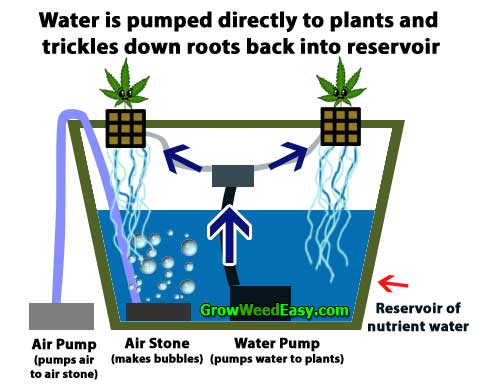
Growing Cannabis with Bubbleponics Diagram
As you can see from the bubbleponics diagram, the cannabis roots have unlimited access to the oxygenated, nutrient filled water, as well as plenty of access to the oxygen in the air. I have personally seen cannabis grow over 2-3 inches a day after being put into this sort of system when it is set up right.
You can use almost any hydroponic nutrients formulated for cannabis that don't have extra junk to clog the pumps, such as the General Hydroponics Nutrient System.
A Few Reminders:
-
Growing marijuana really isn't that complicated, people just make it seem that way!
-
Marijuana is a fairly resilient plant, and can survive a fair amount of stress. Optimally you want to keep your cannabis looking pristine through the whole grow but, don't worry if your plants get a little beat up along the way. I've had plants look rough towards the end and still produce insane buds!
-
If something is wrong with your plants but you can't figure out what it is, change the reservoir water. There are a wide array of problems that this fixes, and the plants like it!
-
Use less nutrients than indicated by nutrient labels. Feel free to experiment and see how your plants react to different amounts, but treat the amount specified on the label as the maximum amount.
-
There's a decent chance that you are going to lose at least a few plants while you're learning. This is totally normal! I'd be more surprised if you somehow managed to not lose any.
How It Works:
Here's the short version. Cannabis Plants have five factors which are important to good growth: Light, Water, Nutrients, Air, Good Temperature, and a "medium"(like soil) to grow in.
Growing cannabis with Bubbleponics works just like growing cannabis any other way. The main difference is that instead of using soil as the medium, you use nutrient-filled, oxygenated water.
The plants also get an added bonus of having some of this water pumped over the base of their roots. These two things make it so that your plants will grow MUCH faster than if they were in soil, perlite, or pretty much any other medium.
Your cannabis roots would drown in the water except that you pump and disolve oxygen directly into the water. This is why you need an air pump and an airstone for your reservoir. They make bubbles in the water.
Setup
Area Setup:
You should always clean and vacuum out your growing area before you start a grow if possible(for bugs, dust, mold, etc.). You may also need to have your bubbler raised off the ground depending on how you plan to drain it; we'll cover that in a bit.
Your grow area will need the ability to stay completely dark for 12 hours a day during the flowering period. Personally, I like to set my plants to flower around 7pm. This makes it so that I have a little time after work to tend to them while their lights are still on. Plus, the plants will be "asleep" mostly during hours when the sun is down anyway which makes it easier to keep them in complete darkness.
About Cannabis Size and Height:
Your cannabis will need room to spread out a bit, so you'll want to keep the total number of plants to 3 or less in a single system.
I generally grow only 1 or 2 cannabis plants in a top-fed DWC system at a time.
You want to keep your plants short, and should therefore start the flowering stage when your plants are around 8"-16" tall.
These numbers aren't set in stone, but some cannabis plants will double or rarely even triple in height after changing the light schedule to 12-12.
The aim is generally to try to get your cannabis to grow wide and bushy. You don't want the plants to get crowded and end up having them compete for space, so it's a good idea to keep them on the smaller side as opposed to letting them grow out of control.
Because your cannabis can grow so fast in this setup, it's imperative that you keep a close eye and don't let them stay in the vegetative stage too long or they will grow into out-of-control monsters that take over your grow space!
Grow Lights:
There are many lights to choose from and a near infinite number of ways to hang them.
This page about different cannabis grow lights goes over the options in more detail, but I'll give you the basics as quickly as I can.
I initially started with CFLs for my first grow. These were great for a small scale grow due to their low setup/maintenance costs and the fact that they don't give off very much heat. I have also experimented with using LEDs to grow cannabis.
High Pressure Sodium/Metal Hallide(HPS/MH)
These are they type of grow lights I use now. Check out a recent grow journal using bubbleponics under a 600W MH/HPS grow light.
These powerful lights pretty much seen as the golden standard for indoor growing lights. They will definitely give your plants what they need to grow huge, but they also make a lot of heat and raise your energy bill.
Because maintaining proper temperatures is so crucial to hydroponic grows, I would not recommend attempting to grow cannabis using either MH or HPS grow lights without a proper ventilation and exhaust system to vent out all the heat and bring in cool, fresh air.
Some growers will get water chillers to keep their reservoir water cold if the grow room is too hot, but water chillers are expensive and are usually unnecessary when your grow area has proper ventilation and exhaust. Learn more about growing cannabis with HPS or MH grow lights.
Compact Fluorescent Lamps(CFLs)
These don't match the power of the HPS/MH combo, but they make much less heat and cost very little. Be cautious though, high wattage CFLs will make a enclosed space pretty hot too! CFL bulbs can be kept as close as two inches from the plant, and in fact should be kept as close as possible since their light is only useful for the first 6 inches or so.
If growing with CFLs, it's best to get many small CFLs and spread them around your plant. You basically want to avoid any shadowed areas which means the leaves in the shadow aren't getting enough light. Learn more about growing cannabis with CFLs.
Light Emitting Diodes(LEDs)
Very low heat, good for your bill, and good output...if you get the right ones. The biggest problem with LEDs right now is that you can get ones that just won't make plants grow correctly. A few CFLs are a great compliment to a good LED lamp. Learn more about growing cannabis with LEDs.
Nutrients:
Which Nutrients To Use:
You can use any nutrients you prefer as long as they're formulated for hydroponic systems(as opposed to soil) and are also specifically made for plants that have a vegetative and flowering stage (like tomatoes).
If you don't know which nutrients you like I would suggest General Hydroponics Flora Trio Nutrients.
How Much Nutrients To Use:
The nutrients that you purchase will most likely come with a feeding schedule, and I would recommend treating that amount as a maximum.
With this grow, you'll start with a fraction of your maximum nutrients and work your way up. However, in my experience, most people end up using significantly less than what the feeding schedule recommends.
When growing with cannabis-friendly hydroponic nutrients (I prefer the General Hydroponics Nutrient trio), I feed my cannabis a little less than recommended in the beginning, but then slowly work my way up if the plant looks like she needs it. Some plants are sensitive to nutrients and will show sign of nutrient burn(too much nutrients) at half strength, while other plants can handle the full-strength dose.
Mixing Nutrients:
You can use an old five gallon water jug to mix your nutrients in. Otherwise, just plain tap will do. Always make sure to "pH" your water before you pour it into the reservoir(see below).
The Importance of Managing pH:
pH'ing Your Water:
After you've mixed nutrients into your water, you need to ensure that the water is the correct pH to ensure that your plants are able to properly absorb the most nutrients.
You will need a pH kit or an electronic pH tester to test the pH of your water. Most pH kits come with instructions, so you should follow those if they're available.
Basically, you want to get a sample of the water you're pH'ing and test it(put some pH test drops in it/place some on a test strip/use your electronic tester).
You can use small amounts of pH up/down to adjust your water to the right level, but don't be afraid to leave the pH within a range. Some nutrients are better absorbed by the roots at a lower pH, while other nutrients need a higher pH to be properly absorbed by the plant's roots.
Therefore when you're making your water, you want to adjust to a pH within the range of 5.5 - 6.3 to ensure proper nutrient absorption.
Step-by-step instructions on how to adjust the pH of your water.
How to Manage the Water Reservoir
Replenishing Reservoir Water:
-
Make sure to add water so it's back to the 'full' mark when it looks like the reservoir has lost about a gallon of water (if you have a smaller reservoir, you will want to top off sooner).
-
When replacing water, you'll want to replace the nutrients in it too, especially after your plants mature and start drinking more than a gallon of water a day. In the beginning you can probably get away with topping off your water with plain, pH'ed water. You can figure out how much nutrients to add to your top-off water by applying the following formula: Take the number of gallons you're putting back in the reservoir, and divide that number by the total number of gallons in your reservoir. So if you're adding in 1 gallon, and your total number of gallons is 5, your number is 1/5. The resulting number is the fraction of your normal nutrient dose you'll need to put back in the tank(I always like to put a little less than whatever number i ended up with). So if you end up with a fraction of 1/5 like in the example, you'll add 1/5 of your normal nutrients (or a little less) to the 1 gallon of water that you're using to top off the reservoir.
-
Minerals will build up in the reservoir and your plants may not use all the nutrients equally, so you'll definitely want to change the entire reservoir of water at least once every 7 days
-
The plants like the 10-15min of oxygen they get while you're changing the water, but don't let the roots dry out.
Draining Reservoir Water:
You will need to fully drain and replace your reservoir water once a week. The method you use to drain the water will be determined by your space/height/financial limitations. Here are some ideas for methods to drain the reservoir:
-
For about $80, you can get an electric water transfer pump to get the water out
-
If you have a drill, you can get a drill pump
-
If you can have your tank sitting high off the ground without running out of future space for lights, you can just drain it into a container, or get a siphon
-
A trick that Roseman uses is to get some hose, and use your hand as a coupling to connect said hose with the top of the water pump. So basically you use your hand to connect your water pump to a hose that leads out of the reservoir. This way, you're using the water pump that's already a part of your system to empty out your tank.
Bubleponics Materials - Supply List
-
reservoir with lid (I get 10-gallon Sterilite containers, you can buy in bulk online or get individual containers from stores like Wal-Mart where they are a few bucks apiece - these containers can be filled comfortably with about 5 gallons of water)
-
net pots (I get the 3.75" NGW net pots)
-
water pump (I use the EcoPlus 185 Submersible Pump)
-
hub aka "drip manifold" (used to split water stream from pump and deliver to each net pot - I use the DiG Corps 6-outlet Adjustable Drip Manifold)
-
air pump - at least one powerful air pump per container (I use one EcoPlus 2 Air Pump w/ 2 Outlets for each 10 gallon container)
-
Tubing for air pump & water pump - 3/16" internal diameter (1/4" outer diameter) vinyl tubing works great with the manifold and the air pump listed above
-
large air stones (I use 2 x large air stones per air pump since the one I use has 2 outlets - this helps make sure there's plenty of oxygen in the water healthy roots and faster growth)
-
24hr timer (I use the Titan Controls 734100 Apollo 8 2-Outlet 24-Hour Analog Timer)
-
hydro starter cubes (rockwool or Rapid Rooters)
-
Hydroponic Nutrients - I use the General Hydroponics Flora Nutrient trio
-
pH testing kit, with pH up, and pH down(or an electronic pH tester)
-
thin rope or light chain with good weight rating (to hold up your grow light)
-
small spool of twistie tie material (I use a combination of gardening twisty ties and soft wire ties)
-
Hydroguard (optional) - supplement for root health
-
mister/sprayer - for foliar feeding and to treat problems (optional)
How to Setup Your Bubbleponics System - Device Setup:
Important: Do not plug anything in just yet
Note: You'll notice that the lid for my system is covered in reflective tape. I did this to reduce the amount of light/heat that gets into the reservoir, however, you don't have to do this. The tape costs ~$5, and you can find it at Home Depot.
-
Start soaking your airstone.
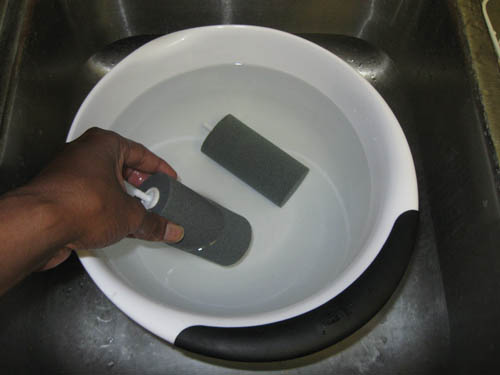
-
Set up your lights.
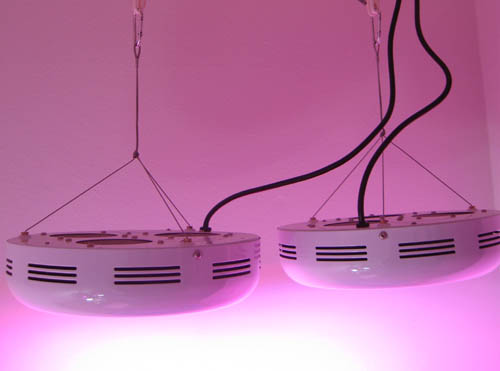
-
Thoroughly rinse your hydroton rocks before you start using them. Rinse them until the water runs clear, and set them aside for now.
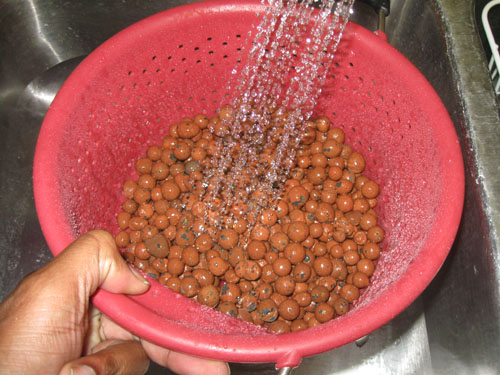
-
If your system is going to be raised off the ground, set up the 'table' your tank will be sitting on and place it under your lights.
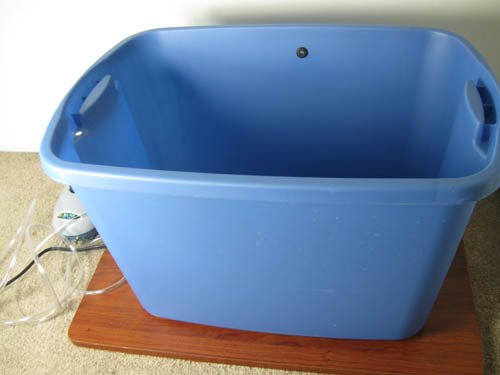
-
Place the airstones on the bottom of your reservoir. Run tubing from airstone out to air pump. Do not plug the air pump in yet.
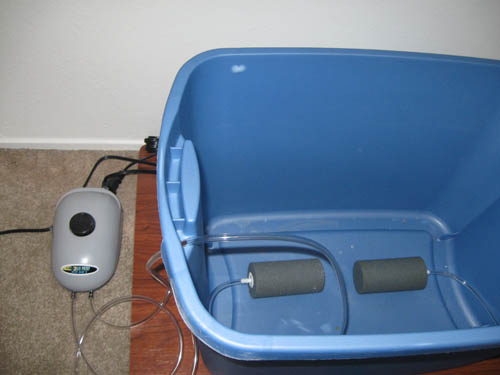
-
Place the water pump in your tank.
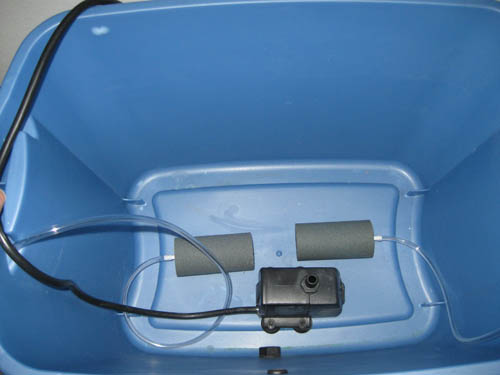
-
Connect thick clear hose to top of the water pump.
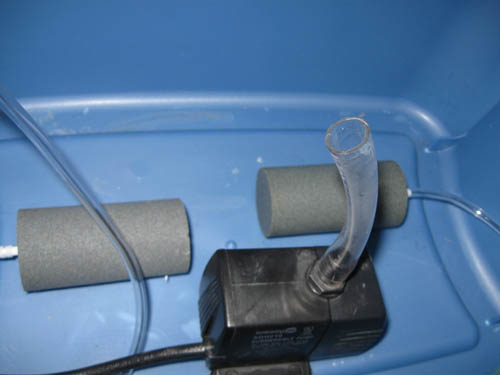
-
Connect the hub(black plastic piece with tubes) to the clear hose. The purpose of the hub is to split the stream of water from the water pump into multiple smaller streams of water.
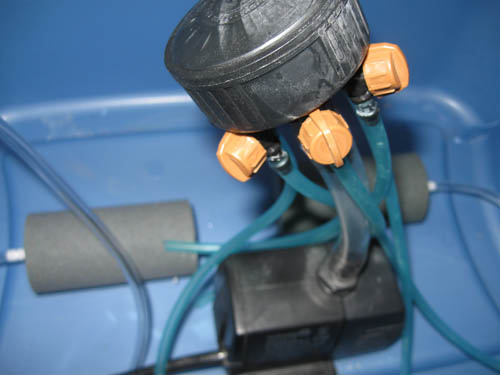
-
With a home-made top-fed DWC system, you'll notice there isn't a good place for the cord for the water pump to exit of the reservoir. You can cut a slot for it, or you can just kinda mash it in near the handles.
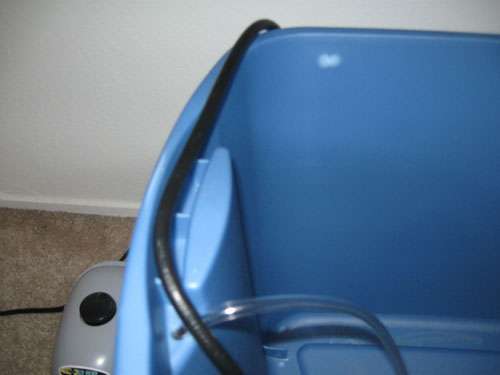
-
Place 5 of the 6 net pots in the lid, and put the lid on the container. You will use the empty slot to pour your pH'd water into the container later.
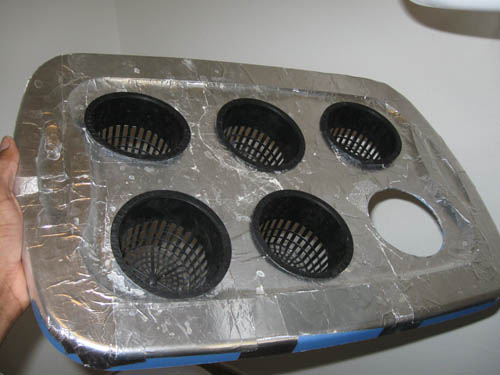
-
Now we need to get water to the net pots which will have plants in them. Lift up a corner of the lid and run one of each of the tubes(from the hub) over into any net pot that will have a plant in it(run them through the top slits in the net pots as shown in the picture).
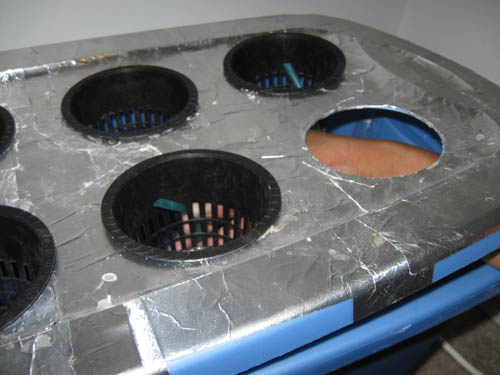
-
Twist the little orange-ish valve on hub for each tube that will going to an occupied net pot. Make the line on the valve parallel to the blue tube to open it.
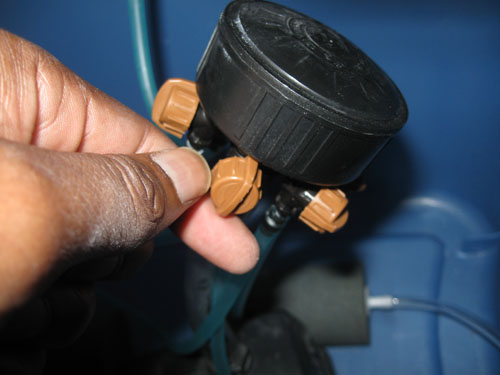
-
Pour 5 gallons of pH'd water into the reservoir. In order to easily mix up 5 gallons of pH'ed water with nutrients, I recommend getting one of those 5 gallon drinking water jugs.
Note: I use tap water and it works fine. This may vary depending on where you live, but it seems that a lot of people have success with tap water. -
Place the last net pot in and run a tube to it if necessary.
-
Now, without dislodging the tubes, pour 1 inch of thoroughly rinsed hydroton rocks into the net pots.
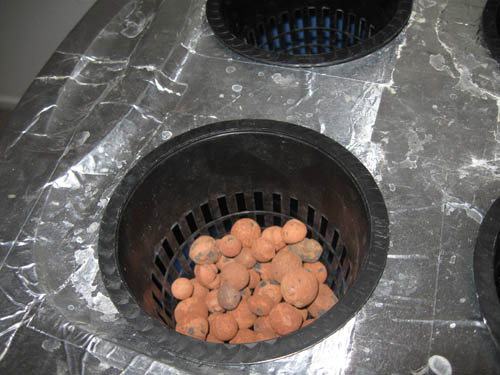
-
Remove the plastic from a rockwool cube. Push a seed down into the top of the cube. You don't want to be able to see the seed, but you don't want it to go farther than a quarter of the way down.
-
Place the cube on top of the 1" of rocks, and run the tube right up against it so the cube and the tube are touching.
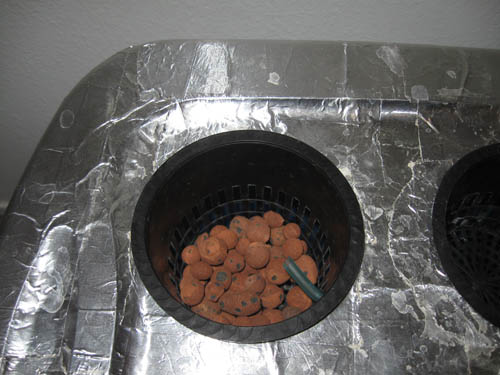
-
With the tube in place touching the rockwool cube, fill up more of the cup with rocks so that the rocks are just barely higher than the top of the cube. Make sure that the tube stays up against the cube while you do this so that the tube will expel water into the cube(and thus, the plant and its roots).
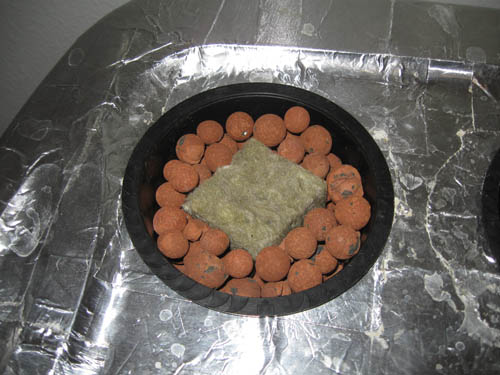
-
Repeat this process for any other net pots you'll be growing in.
-
Use hydroton rocks to completely fill up any net pots that won't have plants growing in them. You don't want any light to get down into the reservoir because light encourages root rot and other root problems.
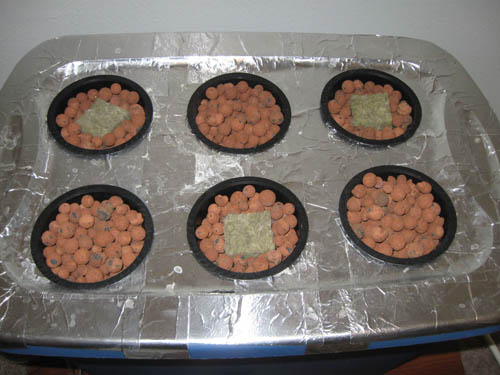
-
Pour some water on the rockwool cubes so they get a little wet all over, but don't drench them. I use plain pH'd water, but you can also use water with light(< 50% dose) nutrients.
-
Another great Roseman trick: Cover the cups with small sized disposable plates. Cut a hole about 1/2 the width of a rockwool cube in the center for the new plants to grow through. I find this useful for blocking light from getting to the cubes and tank, and the paper plates also help keep the rockwool cubes moist.
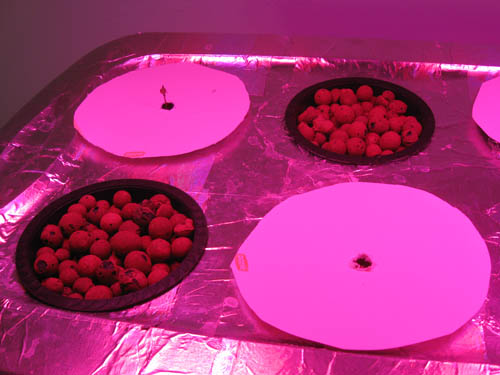
-
Make sure that your lights are plugged into your timer. The rest of your devices(air pump, water pump, fans) should be running 24 hours a day and therefore should not be on a timer.
-
Turn everything on except for the lights. You want to leave the seeds in the dark until you see a sprout coming out of the rockwool cube. If you're starting with clones, they should get reduced light for 3-4 days before slowly increasing to full strength light.
Before You Start:
Now that you're all set to go, you should make start trying to make it a habit to check on your plants regularly. Get familiar with the setup of your container so that eventually, you can check it without looking inside. It's a good idea to regularly check to make sure everything is still connected the way it should be. Make sure the tubes still go to the net pots, and that water is dripping from the occupied pots. You'll also want to make sure nothing is floating in the reservoir water(which should smell clean, or at least neutral). Doing this every so often will help you spot problems if they pop up. Lastly, I want to stress that if your plants are having a problem, draining and replacing their water(don't forget to pH it) is a GREAT way to help them. Healthy plants love it too!
Plant Life Cycles:
Youth(Seedling/Clone):
This is the stage where your cannabis is weakest, but luckily, seedlings don't need much help in the beginning. The key is to be gentle with nutrients, and maintain a pH in the 5.5 - 6.3 range.
Lights:
Seedlings:
Leave your lights off until you see a sprout break the surface. After that point, you'll want to give them light for 18-24 hours a day until it's flowering time. I personally leave my lights on for 24 hours a day during the vegetative stage. CFL lights should be ~4 inches away from the plants, LEDs can vary, but you'll typically want them just a little farther away than a CFL light. For HPS/MH users, you should have the MH bulb in, although some HPS bulbs can be used for the full grow. You can test how hot it is where your plants are with the palm of your hand. If it's hot for you, it's too hot for your cannabis.
Clones:
Give them reduced light(less bulbs if you can) for 3-4 days. This will give your clones time to adjust.
Nutrients:
Seedlings and Clones:
Add 1/4 of the recommended nutrients after 1 week (during your first reservoir change), then add another 1/4 nutrients daily for three days until you're a full strength. Watch the tips of your leaves and back off if they start to appear yellow or brown. Giving plants too much nutrients is a common beginner's mistake, and if you do notice signs of nutrient burn, you will want to drain their water and replace it with water that contains lower amounts of nutrients.
Vegetative Stage:
This is where your cannabis plants grow their fastest and drink heavily. They are also their sturdies and most resilient to problems during this grow stage. The vegetative stage of cannabis growth is the easiest phase since all you have to do is replenish their water(with nutes included) and keep your lights adjusted.
Lights:
Your cannabis grow lights should still be on 24 hours a day. Bulbs with 6500K light temperature are a good choice if you went the CFL route. If you went HPS/MH, now's the time for the MH bulb. You can also successfully use an HPS light or an LED grow light during this stage/
Nutrients:
Since your plants are their sturdiest now, this is the best time to learn how much nutrients they like. You can move closer to giving them the maximum recommended dose, and back off whenever you see the tips of their leaves starting to turn brown or yellow. If this happens, empty your reservoir and fill it back with water and nutrients at the previous safe level.
Flowering Stage:
Flowering is the most worrying time for growers because the plants have more of a visible reaction to stress. Don't worry about minor slip-ups, just watch the plants and you'll be fine. Remember to keep changing your reservoir water weekly and check your roots for color(healthy roots appear white or cream colored, and should never be brown, smelly, or slimy).
Lights:
Set your timer so that the lights are on for 12 hours a day. CFL bulbs with a color temp of ~2700K will better for flowering, and a place like Home Depot will have CFLs in that color range (they're usually labeled as 'soft white' colored). If you went for HPS/MH, now's the time for that HPS bulb.
Nutrients:
Continue with the same schedule as recommending by your nutrients. Most nutrients will have you change to some sort of "flowering" schedule which contains the nutrients a plant needs during flowering. A lot of people will add more nutrients at this stage thinking that the plant will take it in and grow bigger buds, but too many nutrients will only burn your plant so you'll just want to keep doing things the way you have been.
Harvest:
The best thing to remember with harvesting is to be patient. A lot of people get too eager to harvest buds, and they end up taking their plants down too early. Wait for a few signs before you take the leap:
-
The hairs on the buds should curl and retract a bit.
-
Use a jewelers loupe, handheld microscope, or (my personal favorite) a USB microscope, to look at your buds. The trichomes(little mushroom looking growths) should be mostly cloudy, with a few amber ones, and some clear ones. When they're ready, they'll start to lean over from the weight of the bulbs on top.
Once the plants are cut down, you can trim the leaves off of them and hang them up to dry. If their stems break when you try to bend them, they should be done drying. You can also just feel their buds and make a judgment call as to whether or not it feels dry to you. Once your buds are dry, leave them in a airtight jar, and place the jar in a dark place. You can open the jar every so often and jostle the buds a bit; this is also a good time to make sure you don't smell mold. After about 2-3 weeks of this process, you'll have great herb!
Click here if you'd like a more detailed explanation of when and how to harvest and cure your buds.
Other Stuff:
Basic Prevention:
Light
Put your palms up where your plants are. If it's too warm for your hands, it's too warm for your cannabis. In that case, move your grow lights farther away. Most CFLs and LEDs can be placed within inches of the plants, and it even helps their efficiency. Be careful not to let them touch the leaves, though. Even LEDs which are extremely cool can burn the cannabis leaves with too much light, even if they don't burn the leaves with heat.
Water
Check your water to make sure there are no odd smells or objects floating in it. Check your tubes for brownish buildup which could be bacteria.
Nutrients
Too much nutrients can be just as bad as too little. The tips of your plants will tell you if you're using too much nutrients by turning brown. The leaves will turn a more faded color if they're getting too little nutrients or they may show other signs of nutrition deficiencies.
Air
Make sure to have fans circulating air in your grow area. Good circulation will benefit your plants in many ways, including helping prevent mold from growing on their leaves and helping the plant get the CO2 it needs. Direct air from a fan will most likely cause 'wind burn', so aim the fan above or away the plants. You just want the plants to be rustling lightly in the breeze, not fighting to hold themselves up.
Temperature
75 degrees(+/- 5 degrees) is optimal. With this type of growing system, high temperature can be a huge problem(especially in warmer areas). Bacteria loves nutrients and warm water, so your reservoir will be the perfect place for them to reproduce if you can't keep them out. There are two main ways to go about fighting bacteria/algae.
-
The Clean Room Approach: Keep your reservoir totally bacteria free.
Keeping the tank water cool and using something like SM90 to stop bacteria can help ensure your reservoir is a sterile growing environment.
-
The Better Bacteria Approach: Introduce bacteria that your plants actually like.
You can buy 'beneficial bacteria' to introduce to your reservoir. This bacteria will not only outcompete (and thus destroy) the bad bacteria, but it will form a symbiotic relationship with your plants and help them grow. Hygroguard works for this, and I've heard good things about Subculture B although I can't vouch for it myself.
Quick Troubleshooting:
Leaves color fading; lime-ish color:
Plants are underfed or need more nutes
Leaves turn brown on tips and edges; leaves curl down on tips:
Too much nutrients; change water and add less nutrients.
Plants drinking less water than normal:
Plant may be in shock from pH being off. Drain/Replace water and pay close attention to pH level. Your plants will also start drinking less water when they start developing root problems, which brings me to the next point...
Reservoir smells bad, roots are brown, green leaves are falling off:
You may have root rot. If you have brown roots, cut off the brown parts. Replace tank water and add SM90 or Hydroguard to help fight growth. If you've been using SM90, don't switch to Hydroguard or vice versa. Reportedly, SM90 kills all bacteria, so using these two products together is counter-intuitive since the SM90 will kill the beneficial bacteria too.
A lot of people recommend using 35% Hydrogren Peroxide to deal with root rot. I've had root rot quite a few times and tried 35% Hydrogen Peroxide to fix this problem. All I'll say is that for me, it didn't work even close to well enough for me to recommend it to anyone. Even if the roots seemed to be doing temporarily better after being treated with H2O2, the root rot would come back with a vengeance in only 1-2 days. SM-90 and Hydroguard are both methods I've used which will cure your system of root rot long-term and are highly recommended over using Hydrogen Peroxide.
White, flour like substance appearing on leaves:
Most likely white powdery mold. You can make a foliar spray with SM-90 that takes care of that pretty quickly. To prevent a re-occurrence of white powdery mold, increase circulation in the grow area by having a fan or two in the area, control high humidity, and ensure that the temperature of the grow area doesn't climb above a comfortable room temperature.
I hope my bubbleponics cannabis grow guide was helpful! Suggestions, corrections, and feedback are greatly appreciated! Just click the Contact Us link!
Jump to...
How to Grow Weed in 20 Minutes a Week Using Bubbleponics
Get rid of root rot (smelly root slime) once and for all
Which grow lights should I get?
Grow short and bushy plants to maximize your lights
Picture gallery of common marijuana growing problems


